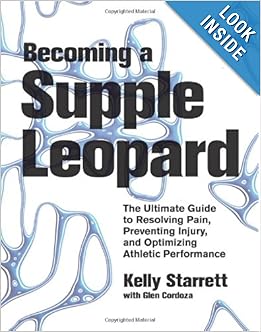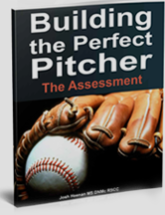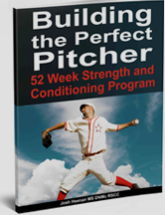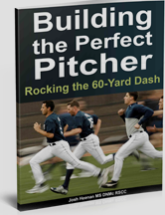Progressing the Reverse Lunge for Improved Performance
Guest post written by Brian Donofrio, C.S.C.S.
When working with athletes (especially our baseball guys), I’ve found the reverse lunge to be one of the best bang for your buck exercises we do in the weight room. It’s great for teaching proper loading of the hips, core control through the sagittal, frontal and transverse planes, as well as building stability, strength and power in a lunge pattern. And the carry over to sport is huge. Whether the athlete is running, throwing, or swinging, developing both stability and strength in the reverse lunge will lead to huge success. And through proper progressions and coaching of the reverse lunge, we can set our guys up to be stronger, faster and more powerful athletes.



Once an athlete successfully learns how to complete a reverse lunge, the benefits are huge. Getting to that point, though, requires allocating the time needed to build a strong foundation for the athlete to be successful in the movement. I’ll go over how exactly we attack the reverse lunge and how we get our guys into great positions that lead to success on the field.
When teaching a reverse lunge, or any exercise for that matter, you need to perfect the athlete’s baseline for the movement before you can progress them and start loading it. For some advanced lifters, you might be able to show them a proper reverse lunge a few times and they immediately crush it. But more often than not we need to start from the ground up, and work our way to performing the reverse lunge.
½ Kneeling Position
For most of our guys, this baseline means just getting them into a perfect ½ kneeling position on the ground. We teach them to have a good amount of dorsiflexion and a positive shin angle in the front leg. In the trail leg we look for full hip extension, and the back ankle dorsiflexed with the toes driving into the ground. We get them set up with the ribs down with the chest tall, neck back and chin tucked. The basic cues we use are to engage the core, feel the hips, and drive the toe into the ground. Here they can understand where we want them to feel tension through lower level activation. It also gives us the benefit of using kinesthetic cues to get the athletes exactly where we want them to be and give them more points of contact to reference and stabilize from. We might also incorporate some thoracic rotational work or overhead reaching in this position to train more dynamic stabilization in the position before moving forward. This allows the athlete to get a basic understanding of positioning and gain a kinesthetic sense for the position we’re asking them to get into.


Split Squat Hold
The next progression is to have the athlete perform a split squat hold (the bottom position of the reverse lunge). We’re looking for similar position as in the ½ kneeling position, except now the back knee is just off the ground, removing a point of contact to the ground. This makes it a more demanding position to be in and further challenges the athlete to build stability in the unilateral pattern. We’ll also incorporate proper breathing techniques to get them more comfortable in this position and improve their ability to hold it for a longer period of time. We typically like to work an athlete up to the point where they can hold that position for about 2 minutes/side. Just like with the ½ kneeling position, adding in rotational work or overhead reaching increases the transference to the field in terms of dynamic stabilization requirements.


Split Squat
Once the athlete is successful with the split squat hold, we can move on to a full split squat. Start with the athlete standing upright, with front and trail leg about 1 stride length apart with feet at hip width. The athlete then descends into the bottom position (the split squat hold described above). We have the athlete briefly pause here before driving back up. The key for carry over to the reverse lunge is to focus on the eccentric and isometric portion of the movement. This helps engrain the pattern and improves the athlete’s kinesthetic sense throughout. To further load this movement we may use a KB in a goblet or unilateral/bilateral front grip hold, a barbell in the front or back position or a safety bar to increase the demand of the tissues and further challenge the stability demands.
Reverse Lunge
As the athlete successfully completes the split squat, with the end positions and movement pattern performed to our standards, we can then start utilizing the reverse lunge in training. The athlete stands tall, with feet even about hip width apart. We’ll start by having the athlete take a step back and sink into the bottom position, holding there for a set amount of time.
The big cue here is to load the hips through the decent, building up tension and force to transfer through the ground on the concentric portion of the lift. We progress with a slight pause at the bottom followed by a powerful drive to the starting position. I coach my athletes to drive at an angle, using the hips to move forward to the starting position as if they are throwing a baseball to home plate or sprinting away from the line of scrimmage towards the end zone. We look to see that the athlete can maintain an upright position in the torso, and is able to stay balanced through the motion without leaning to one side or the other. Make sure the athlete is stabilizing through the core the for the entire lift, which is apparent if they can keep their weight shifted forward rather than swaying back in the bottom position or as they begin the concentric portion of the lift.
As the athlete becomes successful with the movement, we can load it in a number of ways, from a goblet hold with a kettlebell to a safety bar to a barbell. As long as they maintain good positioning and movement pattern, we can really challenge our athletes here.
Summary
If you want your athletes to keep progressing in the weight room, then you have to ensure they master the basics before attempting more complex movements. Give them the framework of proper position and movement patterns in more foundational exercises, and you can see a huge carry over. By establishing a strong foundation through positioning and proper progression, we set our athletes up for success not only in the weight room but on the field. Take time perfecting the basics, and the benefits will be huge for your athletes.
About the Author
 Brian is a strength coach based out of Advanced Therapy and Performance in Stamford, CT. He trains athletes from the high school to professional level, drawing upon his experiences in athletic performance and rehabilitation. He has worked extensively with collegiate athletics at his alma mater, the University of Connecticut, where he earned his B.S. in Exercise Science. After graduation, he worked with UConn Football Strength and Conditioning, as well as with a number of the school’s D1 athletic programs, including Men’s Soccer and Men’s Track and Field, as an undergrad. Brian holds his CSCS through the NSCA. You can find Brian on Instagram or at advancedtherapyperformance.com
Brian is a strength coach based out of Advanced Therapy and Performance in Stamford, CT. He trains athletes from the high school to professional level, drawing upon his experiences in athletic performance and rehabilitation. He has worked extensively with collegiate athletics at his alma mater, the University of Connecticut, where he earned his B.S. in Exercise Science. After graduation, he worked with UConn Football Strength and Conditioning, as well as with a number of the school’s D1 athletic programs, including Men’s Soccer and Men’s Track and Field, as an undergrad. Brian holds his CSCS through the NSCA. You can find Brian on Instagram or at advancedtherapyperformance.com
Want to Run a Faster 60-Yard Dash? START HERE
My right hand man Brian Donofrio did an outstanding presentation on the 40-yard dash for football players. After re-watching this webinar, I realized that he nails down so many points that we attack baseball players with it would be a disservice to not share it with you. This should be mandatory viewing for anyone wishing to play college or pro baseball.
If you have further questions please comment below in the comments sections and Brian or I will follow-up.
Josh’s notes on training the 40 or 60-yard dash:
- In training, we are most concerned with acceleration, not top speed. Teaching someone how to properly accelerate can drop their time .2 in a matter of one session.
- Muscle mass, broad jump, and reverse lunges are great indicators of acceleration potential.
- Stop wasting time running more than 100 yards. Get stronger and everything else works itself out.
- The fastest athletes/best movers I’ve every worked with have amazing abilities to bear crawl.
12-Week Weight Gain Coaching For Baseball Players
12-weeks ago a group of readers started my private distance weight gain program. After an initial evaluation, movement screen, and goal setting we proceeded with both a training and nutritional plan for each athlete.
The groups average results were:
-20lbs of bodyweight gained
-100+ lbs added to their front squat
-125+ lbs added to their deadlift
-10+ reps added to their chin-ups
I couldn’t be more proud of these athletes (and families!) for making the short term sacrifice of eating a large amount of food and truly dedicating themselves to hard training.
Although we do have one problem
I promised the person with the most dramatic transformation to receive a full refund for their hard work. After much deliberation with my colleagues, we have not been able to determine a winner, so I am enlisting you, my readers to help choose a winner.
Please Vote Below– Voting Ends Friday February 5th at Midnight!
Brad
Today I weight 221, a total weight gain of 23lbs. I have been consistent with weight training throughout the entire 12 weeks. I was able to do a dead lift of 255 as of the end of my weight training. Before I started this training, the most I was attempting was 135. When I started I was doing about 4 or 5 chin ups, now I can do 12. Since baseball practice started I have gone out and am only throwing about 70% effort and my coach noticed I’m throwing harder than last year. When I was pitching I was able to get 8 batters out in 25 pitches at practice. The most important thing is that a college coach I’m talking to noticed the big change in my size since I went to their training camp in the summer and they asked me to throw a “tryout” bullpen at the college next week. Each week I followed your advice and I never had a hard time reaching the weight goals; I was usually ahead of schedule. My goal was to get to 220 and I reached that with 2 weeks to go to the end of the weight program.

Garrett
First off, thanks for making my money well spent whether or not Garrett wins the contest. I can tell a difference as well as many friends and family.
Though he didn’t meet the full expectations; we offer the following results:
Total weight gain – 139lb to 159lb
Squats – 135lb to 200lb
Chin-ups – 6 to 25
Pushups – 30 to 70
Dumbbell incline press – 30 lb to 60lb
these are all his working weights, not max outs. – Garrett’s Father
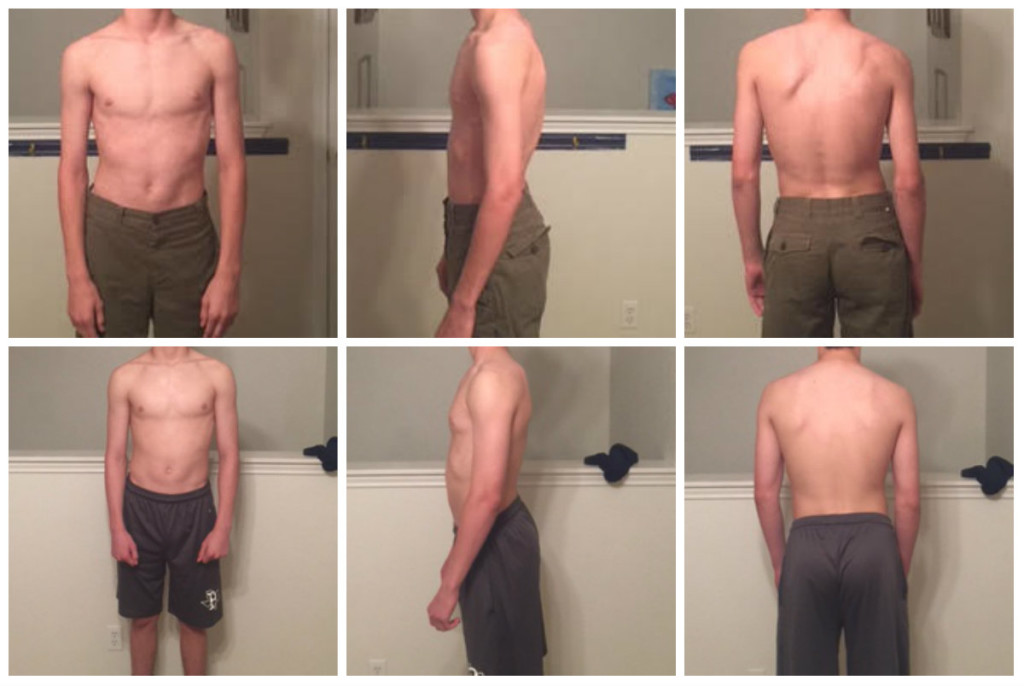
Keanu
My current weight is 171.8 after starting off on an even 148. Being up almost 24 lbs seems huge for 12-weeks worth of work. Strength wise I’ve been noticing major increases in each and every workout, but I haven’t been keeping track of how much exactly except in certain workouts like my rows being up 30 lbs and my deadlift going up 150+ lbs with a max that’s just shy of 200 lbs more than when I first started the program.
This whole experience has been very critical to me in not only playing baseball going forward, but in life because I always wanted to become a bigger person and weighing 150 on a good day wasn’t going to get me anywhere I wanted to go. I wish I could be gained more in this 3 month span, but I’ve learned a lot about how much I need to eat, on top of taking protein and creatine consistently. This definitely won’t be the end of my quest to gain muscle mass and I will without a doubt take what I have learned and incorporate it into my everyday life to become a stronger and better baseball player. Thank you for this opportunity, Josh.
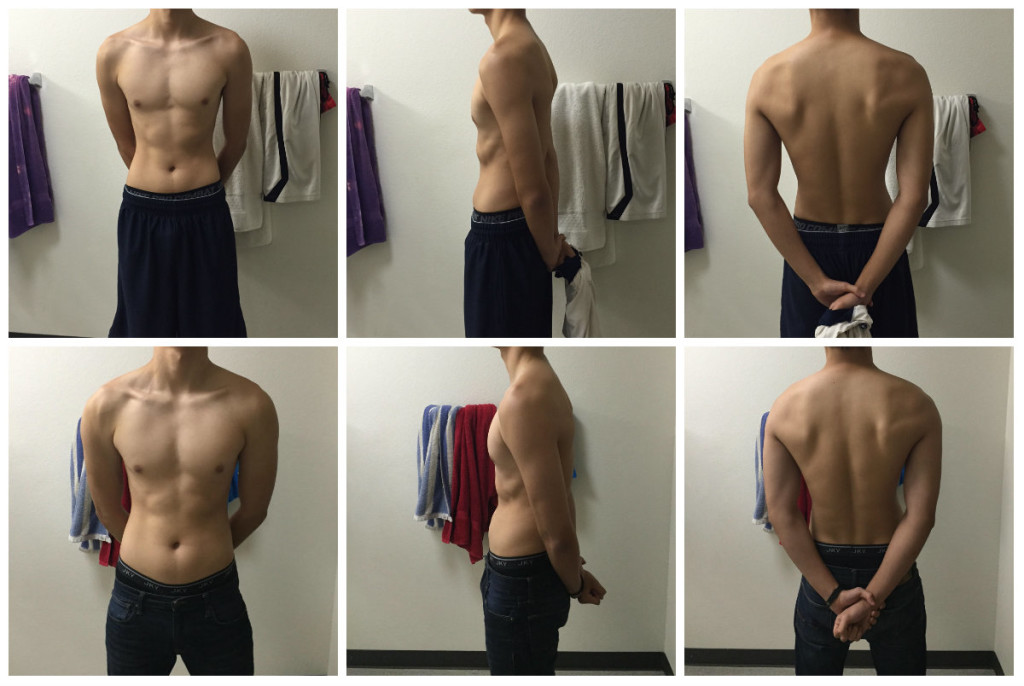
5 Reasons Why You Can’t Gain Weight
Having coached hundreds both in person and as distance clients that routinely put on 20-30lbs in their first 12 weeks of training. I can vouch that many are dedicated to reaching their goals but often have 1-2 major faults that inhibit them from putting on the weight they desire.
Here are my top 5 reasons why people are unsuccessful in gaining weight
5- You are not training with intensity
It’s beyond the scope of this article to dictate if you are on the correct training program or not to gain weight, but regardless of the program, you need to be training with intensity.
Intense training will create the physiological effects that will signal your body to increase muscle mass. Just as important, a solid training program executed with intensity will help increase appetite and allow you to consume more calories over time.
Don’t go through the motions, Train your butt off.
4- You don’t prioritize sleep
Sleep is the time to recover and grow.
Many athletes stay up watching TV and playing video games until 2-4am. Leaving them only 4-6 hours to sleep. When you are able to get deep sleep, your body produces a hormone profile that is optimal for increasing muscle mass and dropping body fat.
For more tips on sleep check out my T-nation article 4 Sleep Strategies for Athletes’
3- You don’t meal prep
This one drives me absolutely nuts.
Without preparing your food in advance you are going to find it near impossible to get enough food in throughout the day. Unless you are a professional athlete, you have to contend with class and/or work on top of everyday life. Having a bunch of meals prepared and snacks always by your side is the easiest way to reach your goals.
I’ve had high school athletes hide PB&J in their backpacks and sneak them in during class or in between class.
I’ve had professional athletes prepare 10-20 meals prior to a long road trip where they know the only options will be McDonald’s for for dinner just about every night.
It doesn’t matter how you get it done, you need to consume enough nutrients for your body to grow. Make it easy on yourself and pack your meals.
2- You have the wrong mindset
Being a skinny kid gaining weight is uncomfortable. It requires preparation, extra time cooking, extra time cleaning, extra time eating, and food will get boring.
GET OVER IT
If it was easy EVERYONE would be their ideal bodyweight, throw 95MPH, and drop 500 foot bombs.
Having a task oriented mindset and understanding that being uncomfortable is a part of the process.

1- You do not have big enough consequences and a support team
I’m a big fan of S.M.A.R.T. goals.
Specific
Measurable
Achievable
Results-focused
Time-bound
Every weight gain athlete I’ve ever had in person or distance coached has implemented S.M.A.R.T. goals with weekly check-ins. These small weekly goals along with surrounding yourself with a team who has the experience and knowledge of how to add some serious weight in a short amount of time makes a world of difference. In our Southport facility, some of the best coaches we have are athletes who have previously gained 30-40 lbs in previous years talking to other athletes.
In regards to consequences, rarely does anyone ever fails to reach their goal when the stakes are high enough. In house, athletes often pick the punishment of eating a can of dog food if they miss a weekly goal. No wonder why no one misses goals.
Move Fast, Throw Hard, Live Well – Early Off-Season
With the fall upon us and our baseball guys entering their off-season, we get an increase in volume of athletes looking to overhaul their fitness and performance training. The follow articles offer good info for the early off-season.
A Peek Into The Sleep Habits Of Teenagers Around The World – Sleep length and quality is not only important for recovery from training and sport, but is immense for long-term health. Sleep is one of the most abused recovery tool we have available for each and every athlete.
High Level Throwing – I had the pleasure of meeting Austin this past winter. Austin does a great job at breaking down high level throwing mechanics. This is the perfect time of year to implement Austin’s tools to fix your mechanics.
Why Your Conditioning is Hurting Your Performance on the Mound – This throwback article gives some insight to how we condition pitcher and prepare our position players to have a powerful first step.
Add Muscle Mass, Get Recruited and Drafted
With the rigorous in-season schedule of games, practice, school, and life adding lean muscle mass can be very challenging. Add in distance running, hot weather, and a lack of training it can feel impossible to maintain bodyweight, let alone add some clean LBS to a wiry frame.
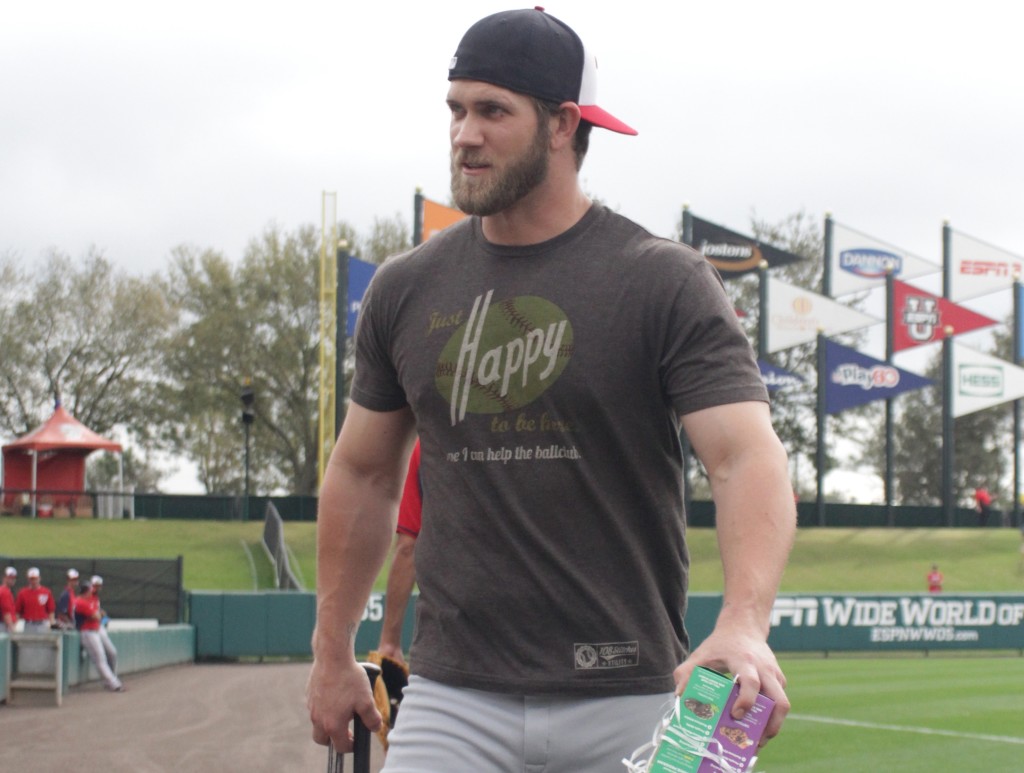
Why is muscle mass so important?
Muscle mass and increased bodyweight increases potential force output, which is one of the keys when trying to run faster and throw harder. Not only is added muscle mass important for injury prevention, but it terms of health and longevity there are few indicators better than muscle mass.
I held a webinar last year and release my “90 MPH Formula”. As you can see below, I’m a huge believer that strength gains and bodyweight are near necessity to throwing above 90. Mechanics and a whole host of factors play into this, but my athletes have shown me the information listed is accurate over and over again.
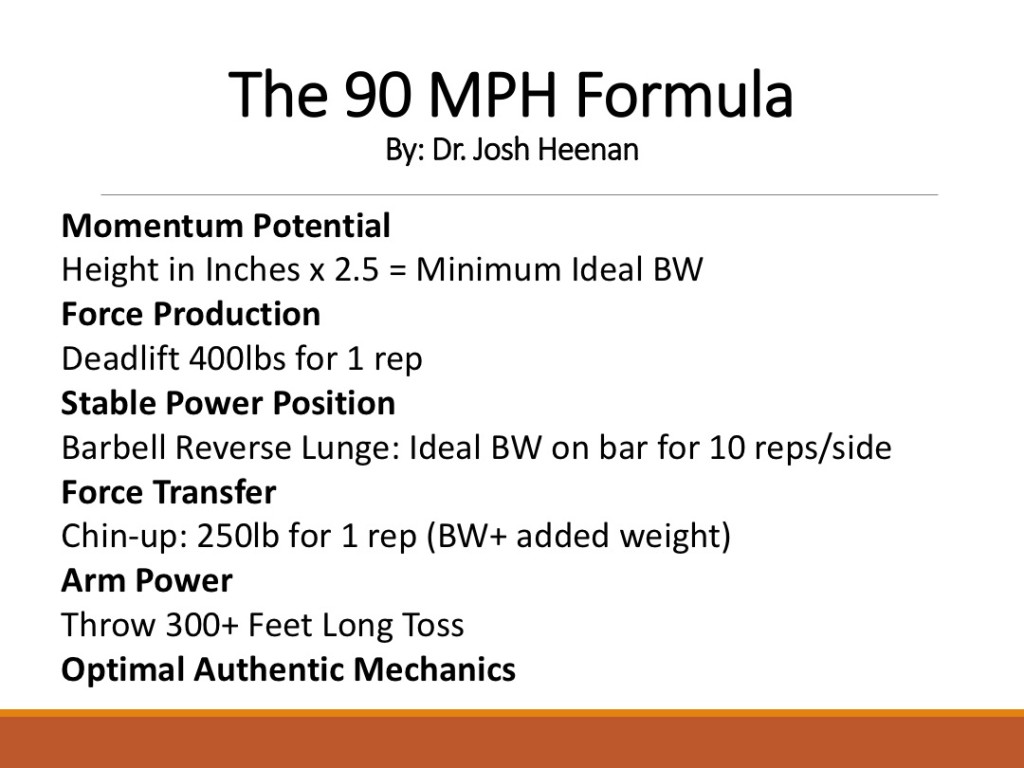
I encourage you to compare your favorite collegiate or MLB team roster to the “90 MPH Formula”.
The performance indicators and decreased risk of injury are great for athletes, but why else would this matter for collegiate coaches and MLB organizations?
Dedication/Toughness
For the most athletes, adding a significant amount of muscle mass requires intense dedication. Having seen 100+ athletes add 20 lbs in 10 weeks, I know this is not for the faint of heart. The ones who go on to add 30-40 lbs over a 6 month period have a level of need for the weight and self-discipline that is impressive to say the least. Dedication, toughness, and sacrifice for a larger goal (like significant muscle gain) is something all highly competitive teams want.
Projectable/Image
Baseball, like most sports, is highly speculative. As I tell our draft eligible guys, all it takes is one scout to fall in love with you and you will be picked up. Same holds true for college coaches. Being undersized by 30-50lbs while being scouted or recruited is going to portray a less than ideal image of what you can offer, even if you are an exceptional athlete. As one of my good friends often says “dress for the job you want, not the job you have” prior to your college visits or your draft eligibility it is important to present yourself physically prepared for that next level of play. Leverage your opportunity to have those coaches speculate you are the hardest worker they have ever met.
During the first day of the MLB draft coverage, the hosts continually commented about how a bunch of the athletes were “gym rats”. They classified these guys as “workers” and would be an asset to each ball club they were about to join. Many college and pro organizations see the value of athletes who train hard, are more durable, and reach their potentials. Take the time now to dedicate yourself to being consistent while training hard and smart year-round.
Want to play college baseball? This weekend, you must do this.
Watch College Baseball
The NCAA Regionals are played continuously from Friday to Sunday on ESPN U, ESPN 3, and the SEC Network. Can’t make it because you have games all weekend? DVR a few of the games and watch them Sunday night.
Take this yearly opportunity to learn about your potential competition. Analyze the physical attributes of each player, how they play the game, how fast they run, how hard they throw. So often I work with players who want to play college baseball, but have no idea what the talent pool is like at that level.

Check out the rosters of some of the known powerhouses. For instance, Texas has only 4 players listed under 180lbs. Of the 17 pitchers on their staff, Texas has only 1 that is under 180lbs, and he is a freshman. Weight is not the end all be all for baseball players, but it is absolutely one indicator of how well someone is built (assuming the athletes are lean). Adding muscle mass is one of the easiest ways to increase mph on the mound, decrease injury risk, and raise your overall athletic potential.
Why bodyweight is important for pitchers
The speed of the college game is often surprising for high school athletes, especially at the high echelon DI programs. In 2013, Perfect Game published this list of the fastest high school sophomores, juniors, and senior 60 yard dashes.
Averages: High School Senior 7.31 | Junior 7.44 | Sophomore 7.56
Top Performers – 60-Yard Dash – Class of 2014
| RK | Time | Name | Event | School | City | State |
| 1 | 6.28 | Carl Chester | National Showcase | Lake Brantley | Longwood | FL |
| 2 | 6.31 | Denz’l Chapman | National Showcase | Serra | Los Angeles | CA |
| 3 | 6.35 | Jared McKay | Southeast Top Prospect Showcase | Chamblee Charter | Stone Mountain | GA |
| 4 | 6.36 | Evan Holland | Mid Atlantic Top Prospect Showcase | Timber Creek | Erial | NJ |
| 5 | 6.37 | Jack Flaherty | National Showcase | Harvard-Westlake | Burbank | CA |
| 6 | 6.42 | Clay Lane | Sunshine South Showcase | Kaufman | Kaufman | TX |
| 7 | 6.43 | Michael Gettys | National Showcase | Gainesville | Gainesville | GA |
| 8 | 6.44 | Derek Hill | National Showcase | Elk Grove | Sacramento | CA |
| 9 | 6.45 | Connor Brady | South Top Prospect Showcase | Plano Sr. | Plano | TX |
| 10 | 6.46 | Matthew Collins | National Showcase | Memorial | Houston | TX |
| 10 | 6.46 | Trenton Kemp | National Showcase | Buchanan | Clovis | CA |
| 12 | 6.47 | Troy Stokes, Jr. | National Showcase | Calvert Hall College | Baltimore | MD |
| 12 | 6.47 | Stone Garrett | National Showcase | George Ranch | Sugar Land | TX |
| 14 | 6.48 | Tristan Rojas | Sunshine Northeast Showcase | James Monroe | Bronx | NY |
| 15 | 6.49 | Landon Morgan | South Top Prospect Showcase | Lubbock Christian | Levelland | TX |
| 15 | 6.49 | Giovanni Abreu | National Showcase | George Washington | New York | NY |
| 15 | 6.49 | Jeren Kendall | National Showcase | Holmen | Holmen | WI |
| 15 | 6.49 | Alexis Pantojas | Caribbean Top Prospect Showcase | Puerto Rico Baseball Academy | Vega Alta | PR |
Top Performers – 60-Yard Dash – Class of 2015
| RK | Time | Name | Event | School | City | State |
| 1 | 6.44 | Satchel McElroy | Jr National Showcase | Clear Creek | League City | TX |
| 2 | 6.45 | Demetrius McAtee | South Underclass Showcase | Parkway | Bossier City | LA |
| 3 | 6.46 | Alex Shaver | Jr National Showcase | George Ranch | Sugar Land | TX |
| 3 | 6.46 | Bakari Gayle | Jr National Showcase | Martin Luther King, Jr. | Stone Mountain | GA |
| 5 | 6.50 | Eric Cole | South Underclass Showcase | Southlake Carroll | Southlake | TX |
| 6 | 6.51 | Connor Smith | Ohio Valley Showcase | H.H. Dow | Midland | MI |
| 7 | 6.54 | Roman Millem | Ohio Valley Showcase | North Oldham | Prospect | KY |
| 7 | 6.54 | Jimmy Herron | Jr National Showcase | La Salle College | Harleysville | PA |
| 9 | 6.55 | Daniel Little | National Underclass Session 3 | Lexington Catholic | Nicholasville | KY |
| 10 | 6.57 | Demi Orimoloye | Jr National Showcase | St. Matthew | Orleans | ON |
| 10 | 6.57 | Bakari Gayle | Southeast Top Prospect Showcase | Martin Luther King, Jr. | Stone Mountain | GA |
| 12 | 6.59 | Tyler Williams | Jr National Showcase | Raymond S. Kellis | Peoria | AZ |
| 12 | 6.59 | Shane Selman | Sunshine South Showcase | Alfred M. Barbe | Lake Charles | LA |
Top Performers – 60-Yard Dash – Class of 2016
| RK | Time | Name | Event | School | City | State |
| 1 | 6.62 | Vincent Ramos | Caribbean Underclass Showcase | Colegio Bautista | Toa Baja, Levittown | PR |
| 2 | 6.64 | Nicholas Rowland | Mid Atlantic Underclass Showcase | Chestnut Hill Academy | Blue Bell | PA |
| 3 | 6.67 | Ryan Mejia | Sunshine East Showcase | Alonso | Tampa | FL |
| 4 | 6.72 | Matthew Meisner | Sunshine Northeast Showcase | Salem | Salem | NH |
| 5 | 6.78 | Christian Moya | California Underclass Showcase | Bishop Amat | Chino Hills | CA |
| 6 | 6.79 | Cameron Locklear | Atlantic Coast Underclass Showcase | Jack Britt | Fayetteville | NC |
| 7 | 6.82 | Tyrik Jones | Southeast Underclass Showcase | The Galloway | Stone Mountain | GA |
| 8 | 6.83 | Corbin Bice | Southeast Underclass Showcase | Chilton Co. | Clanton | AL |
| 9 | 6.83 | Aidan Elias | Ohio Valley Showcase | Sayre | Lexington | KY |
| 10 | 6.84 | Kace Massner | Midwest Underclass Showcase | Burlington Community | Burlington | IA |
| 11 | 6.85 | Isaac Collins | Midwest Underclass Showcase | Maple Grove | Maple Grove | MN |
| 11 | 6.85 | Austin Bodrato | Sunshine Northeast Showcase | St. Joseph Regional | Northvale | NJ |
| 11 | 6.85 | Ashton King | Atlantic Coast Underclass Showcase | Christiansburg | Christiansburg | VA |
Source: http://www.perfectgame.org/Articles/View.aspx?article=9177
As you can see, the average senior in high school ran a 7.3 60-yard dash, which is not overly impressive. That 7.3 average is largely made up of athletes who will never step foot on a college ball field. Of high school varsity baseball participants only 5.6% will play at the collegiate level.
Only 5.6% of high school baseball players ever make a college team. As a high school athlete, are you REALLY outworking the other 95%?
— Josh Heenan (@josh_heenan) May 25, 2015
What is impressive is the fastest sophomore ball players run between a 6.44 and 6.85. That is blazing fast for an underclassman. To even come close to breaking the top 15 for the senior class you must run under a 6.5, which is plus speed for an MLBer.
So how do you stack up?
Not sure how hard you throw? Get on the gun at your next outing.
Not sure how fast you run? Go to a track and video tape your 60 yard dash. Video does not lie, handheld timers do.
Be analytical with the games you are watching this weekend and see how you would compare against the competition and what aspects of your game need the most work.
Have questions or comments about playing at the next level? Leave a comment below.
Random Thoughts – Baseball Preseason Training
With spring sports about to formally start in a few weeks, emails have been pouring in. Here is a collection of thoughts from the past week.
Training has a very profound effect on an athlete’s performance
Unfortunately, like many things in life, it takes some time to get the ball rolling and reap the full benefits of training. Do we often see outstanding results in movement, strength, and performance in a short time? Absolutely. But if you think you are going to drop .2 sec off his 60 or 40-yard dash by next week’s showcase, you are missing the point of athletic development. Skill, speed, strength, and athletic development does not happen overnight; it’s a process.
Risk can be minimized
I am not a Basketball fan per se. I am however a huge fan of the qualities that a great basketball player has—hand eye coordination, great shin angles, speed, power, and endurance to name a few.
For baseball players, I can’t think of too many things with a higher risk-reward ratio than recreational/pick-up basketball. As my readers know, I am all for playing multiple sports, especially when younger, but the rate at which broken/sprained ankles, fingers, or wrists for kids “just trying to get some conditioning in” makes playing basketball not worth it unless you really love the game. With the short twenty-game New England high school baseball season, one good ankle sprain or jammed finger could mean missing half of your season.
In fact, after my 1st full season as Sacred Heart University’s Baseball Strength Coach, we forbid our players from playing basketball. Instead, I encouraged tag, dodgeball variations (not using dominant arm), and touch football.

Speed changes everything.
Rarely do you see a kid who consistently throws in the low 70s have arm pain.
Rarely do you see a kid who consistently runs an 8.0 60 yard dash pull their hamstring bad enough where they miss more than a week of their season.
Athletes and coaches need to understand how to progress throwing and speed work to mitigate short and long-term injuries. It is very difficult to have only 2-3 weeks of preseason with your team, as coaches need to make cuts and figure out whom the best players are.
Want a trick to incorporate speed and conditioning work without subjecting athletes to unneeded hamstring pulls?
Hill Sprints
Why hill sprints?
With the incline of the hill you are forcing your body into good acceleration positions, without subjecting yourself to the faster velocity required in flat ground sprints. The accelerated position also prevents over-striding and over-using the hamstrings to pull you forward (no heel landing). You want to be accelerating by pushing the ground behind you, instead of pulling you forward. So, hill sprints self corrects and teaches near optimal running mechanics without having to think about it. Hill sprints are also much more anaerobic in nature which is very applicable for baseball players. Especially the weaker, slower ones!
How do you implement this?
Week 1- Tryouts:
Start with your normal baseball skill work, but everyday at the end of practice find a steep hill and have players (pitchers included!) sprint for 20 seconds up the hill and walk back down. This can be a safe grassy hill or a pavement hill. Do 6-10 rounds of this with 2-5 minutes of recovery between sprints. Record where each player ends at the end of 20 seconds. Very quickly you will know who is “in good shape” and who is powerful and athletic. Not to mention you are avoiding god-awful distance running.
Week 2- Normal Practices:
M/W/F do 6-10 sets of 20 second hill sprints with near full recovery.
Tu/Th do 6-10 sets of 10-20 yard dashes on flat ground ~80% (full recovery in-between sets)
Week 3- Normal Practices:
M/W/F do 6-10 sets of 10-20 yard dashes on flat ground ~90% (full recovery in-between sets)
Tu/Th do 4-6 sets of 20 second hill sprints with near full recovery.
Obviously, if athletes were properly trained going into the season the coaches wouldn’t have to worry about this as much, but this is a safe way to protect the athletes and prepare them effectively.
Move Fast, Throw Hard, Live Well- Stealing Bases, Moneyball, and In-Season Body Care
Clients and friends were sending over lots of great articles this week for me to share as well as some resources I suggest to my athletes for self-care.
This is a great feature on how the Red Sox play Moneyball with the ability to spend some serious cash. Here they speak to how they handle injuries, especially soft tissue work.
Boston’s approach to treating conditions like Ortiz’s is simple, yet brilliant. For most teams, the process of getting players healthy and keeping them that way has remained the same for a long time. Every club employs a small group of trainers and a strength and conditioning coach, and many also employ an orthopedist. This personnel group is built for broad treatment, because baseball players suffer a wide array of injuries. The Red Sox, however, have come to believe that broad treatment isn’t enough, and that specialization is an essential part of fostering player health.
“We recognize that the management of soft tissue is the critical component to a player’s health,” said Red Sox GM Ben Cherington. “As it relates to David [Ortiz], that was an issue of soft-tissue management. His Achilles had not ruptured. There was no broken bone. He was a 36-, 37-year-old who had soft-tissue management issues that were causing a lot of pain and discomfort. It wasn’t a lack of effort on his part to get better. We just had to figure out what would help him do it.”
In the same way that teams employ roving pitching, hitting, fielding, and baserunning coaches to help players focus on certain elements of their game, the Red Sox realized they could find specialists to deal with these soft-tissue concerns. Physical therapists craft regimens to help players avoid the kind of nagging injuries that can linger for far too long; when those injuries do occur, they can help players recover in weeks instead of months, or days instead of weeks. In essence, the Red Sox are using a physical therapist like a roving medical coach. This helped Ortiz last year, and the Sox hope it will help players like the oft-injured Grady Sizemore this year. In fact, if the Red Sox weren’t this confident in their health regimen, they probably wouldn’t have gone after a beleaguered player like Sizemore at all.
While Cherington understandably wouldn’t go into great detail about the team’s physical therapist program, he lit up when talking about the potential benefits. “If we can find people who are at the top of their field to be hands-on with our players and create, I don’t know, a 5 percent difference in how much [the players are] out there or their level of physical fitness when they’re out there, that can translate into greater performance. So, yes, we have spent a lot of time on the medical area in the last two years, and that’s only going to continue.”
Kelly Starrett is a physical therapist/strength coach best know for his work with with self joint mobilization. Becoming a Supple Leopard is an easy to use guide that will highlight limitations and show you exactly how to address those restrictions.
The Trigger Point Therapy Workbook is another guide which allows athletes to find soft tissue restrictions that can limit performance and cause referred pain. No only is this book great for athlete’s but people that have everyday aches and pains can put this very inexpensive book to use in only minutes a day. I have first hand seen athletes gain complete shoulder mobility back with just a few minutes of soft tissue work to the pecs and infraspinatus (detailed in the book).
Would A World-Class Sprinter Be The Best Baserunner In MLB?

Sam Miller absolutely crushes this article on key components to being a successful base stealer. A must read for runners, pitchers, coaches, and fans.
Portraits: NY Yankees John Murphy
The All In Productions crew produced a great feature on one of our athletes, John Murphy. Take a moment and see what makes this athlete motivated to make the show.





